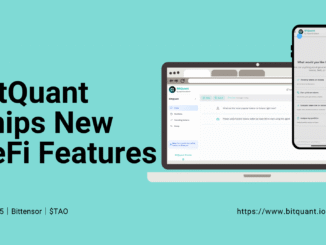
The 36th episode of Bittensor Revenue Search featured Open Gradient, the team behind BitQuant (Subnet 15 on Bittensor), an ambitious project building AI-powered financial advisors.
BitQuant’s co-founder, Matthew, and the Chief Strategy Officer, Advait, joined hosts Mark and Siam to unpack how BitQuant is turning quantitative finance into an on-chain, accessible experience for everyone — from seasoned traders to casual crypto holders.
From Wall Street to Web3
Matthew, a former quant researcher at Two Sigma, and Advait, a PhD-trained data scientist and former UCL lecturer, bring deep expertise from both traditional finance and AI. Together with Adam, their Chief Technology Officer (CTO) and former AI lead at Palantir, the team’s combined experience spans machine learning, quantitative analysis, and high-performance systems.
That background, Matthew said, was key to building BitQuant — an “AI agent that functions as a pocket financial advisor.”
“Today’s markets are noisy,” he explained. “People see prices move but rarely understand why. Quantitative analysis lets us uncover the patterns and data signals that actually drive those price changes — and we’re making that capability accessible through BitQuant.”
What BitQuant Actually Does
BitQuant operates as an AI-powered financial assistant built on Bittensor’s decentralized network, where miners compete to generate the best analytical responses to real user queries.
Users can connect their wallets on bitquant.io, chat with the AI, and get insights like:
1. “Why did Ethereum crash this week?”
2. “What tokens are trending on Base?”
3. “Where can I earn the best yield on my USDC?”
The AI pulls from real on-chain data, offering both explanations and actionable suggestions — even enabling swaps and portfolio management directly through the chat interface.
BitQuant gives users a simple, conversational way to interact with DeFi — no dashboards, no manual bridging, no spreadsheets.
How It Works Under the Hood
BitQuant is powered by Open Gradient, a layer-1 infrastructure network designed to run AI inference and host models on-chain. This allows the team to build fully verifiable, decentralized AI agents that reason, transact, and learn directly on blockchain rails.
The system leverages Bittensor’s miner-validator dynamic:
1. Miners compete to produce the best analytical responses.
2. Validators evaluate outputs using an LLM-as-a-judge mechanism, improving quality over time.
This open competition means BitQuant continually evolves — each miner’s innovation improves the collective intelligence of the subnet.
Traction and Early Growth
BitQuant’s adoption has been striking. According to the team, the platform has over one million registered users and roughly 50,000 weekly active users — with recent integration of swap functionality generating $200,000 in trading volume in its first week.
The platform currently supports Base, Sui, and Solana, taking a 0.5% trading fee per swap. Future updates will expand cross-chain functionality and introduce features like limit orders, stop-loss settings, and automated portfolio management.
Despite the impressive metrics, Advait acknowledged that early user counts include some incentivized traffic from a points campaign — a common phenomenon in crypto launches. “The real metric that matters is volume and active usage,” he noted.
On Incentives, Compliance, and Decentralization
When asked about BitQuant’s tokenomics, the team emphasized compliance caution. Revenue from the platform, they explained, is intended to flow back into subnet development and community incentives — though discussions around buybacks or redistribution remain hypothetical pending legal clarity.
“We want BitQuant to function as a decentralized organization, run by its miners and validators,” Matthew said. “Revenue should drive innovation and long-term sustainability, not short-term speculation.”
Funding and Vision
One detail that surprised even the hosts: Open Gradient has raised $8.5 million, led by A16z Crypto and other investors. That funding supports the broader vision — to move AI computation fully on-chain and build an ecosystem of verifiable AI agents that interact transparently with digital assets.
Subnet 15 is just the beginning. “BitQuant is our first practical implementation,” said Advait. “But the infrastructure we’re building through Open Gradient could power countless decentralized AI applications — not just in finance, but across the web.”
Challenges and the Road Ahead
The conversation didn’t shy away from challenges. The hosts pressed the team on AI reliability, prompt injection attacks, and the risk of retail overreliance on automated advice. The BitQuant’s team responded candidly:
1. BitQuant uses strict evaluation filters and remote attestation measures to maintain response quality.
2. Clear disclaimers and educational content are being added to help users understand how to use the system responsibly.
3. Future updates will include risk flags (e.g. wallet concentration, token volatility) to prevent uninformed decisions.
They also confirmed that mobile access is in development, with the goal of simplifying onboarding for non-technical users through voice and smart wallet interfaces.
Six-Month Roadmap
For the next phase, the team outlined two main priorities:
1. Improving the validator system to better detect and penalize low-quality or manipulative responses.
2. Expanding the front-end experience, integrating swaps across more networks, and preparing for a mobile launch.
“Ultimately, we want BitQuant to be the de facto entry point for anyone curious about crypto,” Matthew said. “A single chat interface that makes DeFi intuitive.”
Finally…
BitQuant isn’t just another AI chatbot. It’s a living financial layer, where decentralized AI agents compete to provide real insights — powered by blockchain transparency rather than hidden algorithms.
For Bittensor, it’s another step toward its broader vision: a network of autonomous, open systems where intelligence — and economic value — are both distributed.


Be the first to comment